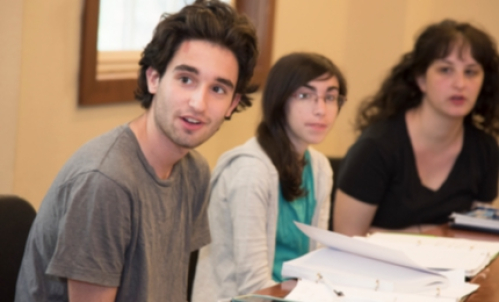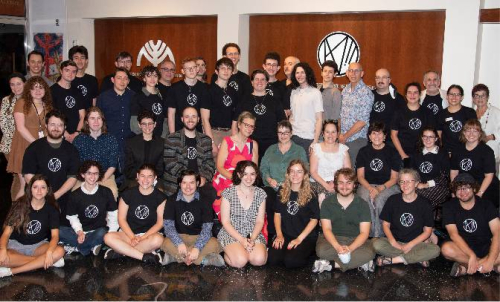Yiddishland: Countries, Cities, Towns, Rivers
YIVO is pleased to introduce Yiddishland: Countries, Cities, Towns, Rivers. This is the first attempt to collect and publish all Yiddish place names of Central and Eastern Europe in one book. We have now made available place names found in all the countries of Eastern Europe.
Yiddish place names are both a fascinating topic and something of a sore subject. Because everywhere they have lived, Yiddish speakers have been a minority, and since the language has almost never had government recognition or backing, it is miraculous that standardization has been possible. In the case of place names, standardization has been particularly difficult, as the Yiddish folk designations for cities, towns, rivers, and even city streets have often been ignored by the speakers themselves, not to mention Yiddish journalists and writers who are more familiar with the official names. Thus, a gazetteer of Yiddish place names has been a desideratum for many, many years. In YIVO-bleter VII (1934:229), the editor notes that Saul Chajes's list of Yiddish place names, which was published in that issue, will be "an important contribution to the Yiddish geographical index that is being prepared by the philological section of YIVO," which to the best of our knowledge never appeared.
As with so many other projects, the late Mordkhe Schaechter took it upon himself to collect and publish a definitive list of Yiddish place names. Although he did not live to complete the project himself, his extensive card files, with nearly 6,000 Yiddish place names culled both from oral interviews and printed sources, were donated to YIVO. The gazetteer, titled Yiddishland: Countries, Cities, Towns, Rivers, has been compiled in its present form by Paul Glasser, who supplemented Schaechter's files with more recent published data and with Internet sources, particularly with respect to official names. Although Schaechter collected Yiddish names from around the world, the present work is limited to approximately 3,000 locations in Central and Eastern Europe, specifically present-day Austria, Belarus, Czech Republic, Estonia, Hungary, Latvia, Lithuania, Moldova, Poland, Romania, Slovakia, and Ukraine, as well as the European regions of Russia. This includes what Mikhl Herzog (1965:7) designates "Yiddish Language Area (1938)," as well as neighboring countries with at least a few Yiddish place names of long standing.
This work is prescriptive as far as is practicable. The Yiddish names reflect the pronunciation of the natives of the respective location rather than the spellings that are most widespread in published sources, which tend to be based on official usage. To orient the reader to the normative approach of this work, we reprint here in English translation part of a chapter of Schaechter's Laytish mame-loshn (Authentic Yiddish) entitled "Yidishe geografishe nemen" (Yiddish Geographical Names; Schaechter 1986:17-18):
People don't seem to understand that not taking the trouble to find out a Yiddish place name, and using the official name instead, is a sign of negligence, an insult to our own language. Even places that were never part of a particular country still have their own names in the respective language. Vienna and Munich [in German: Wien and München] will always be known in Polish as Wiedeń and Monachium. The same is true of English: foreign cities that have English names are always called by their English names, not with their official names: Cologne, Munich, Vienna, Naples (not Köln, München, Wien, Napoli). Why is that? Don't they [English speakers] know the "correct" names? Of course; but their own language s their language and so they used the correct names in their language.
[In the last few years, we have noted a tendency in English to spell foreign cities according to the official language (e.g., "Krakow" in English instead of the traditional “Cracow," “Marseille" and "Lyon" instead of "Marseilles" and "Lyons") and even to pronounce them thus (the Italian city that was the site of the 2006 Winter Olympics is called “Turin" in English, but American television commentators, while speaking English, used the Italian name: "Torino"!]
What is the Yiddish name of a place? The name used in normal speech by the Yiddish speakers native to the place. As Yudel Mark put it: "The question of spelling is not directly relevant to the [...] matter of Yiddish geographical names. In this instance, the spelling should reflect what Yiddish speakers actually called the cities and countries where they lived. The more deeply rooted spoken tradition takes precedence over the written tradition" (1958:92).
As to the question of how and why Yiddish place names came into being, Stankiewicz states (1965:181):
... If the Yiddish place names are in the end result so different from their Slavic equivalents, it is because, strictly speaking, they were not borrowed but adopted, reinterpreted and fused with the other components of Yiddish, with which they shared the same historical development. The history of the Yiddish place names ... is the clearest illustration of this process of uninterrupted linguistic adaptation and fusion which determined the structure of modern Yiddish.
The Yiddish language has its own rules of historical development, in its phonological, morphological, and grammatical systems, which the corpus of names in this work illustrates in great detail. To put it very simply: place names, in particular when derived from the Slavic languages, were reinterpreted to fit Yiddish speaking habits. Perhaps the best example is Zhetl (in western Belarus), which appears to be a compromise between Polish (Zdzięcioł) and Belarusian (Dyatlava).
Among the toponymic lists published to date; Shloyme (Salomon A.) Birnbaum (1918:180-181), Florence GuggenheimGrünberg (1965), S. Winter (1929), Saul Chajes (1934), J. Taglicht (1926), and M. Laserson (1942). Additional sources: Yidishe shprakh XXXVI (1977): 20. There is also a sizable literature about the principles of Yiddish place names: Franz J. Beranek (1951), Max Weinreich (1973 [II]:207-252), Edward Stankiewicz (1965), et al., as well as much relevant information in the dialectological studies of Mordkhe Veynger, Uriel Weinreich, and in particular Noah Pryłucki. The most comprehensive alphabetical list is Birnbaum's (1979:135-141); a new edition, with the many typos corrected, is now in press.
For more detailed information, please download "Yiddishland: An Introduction.”

